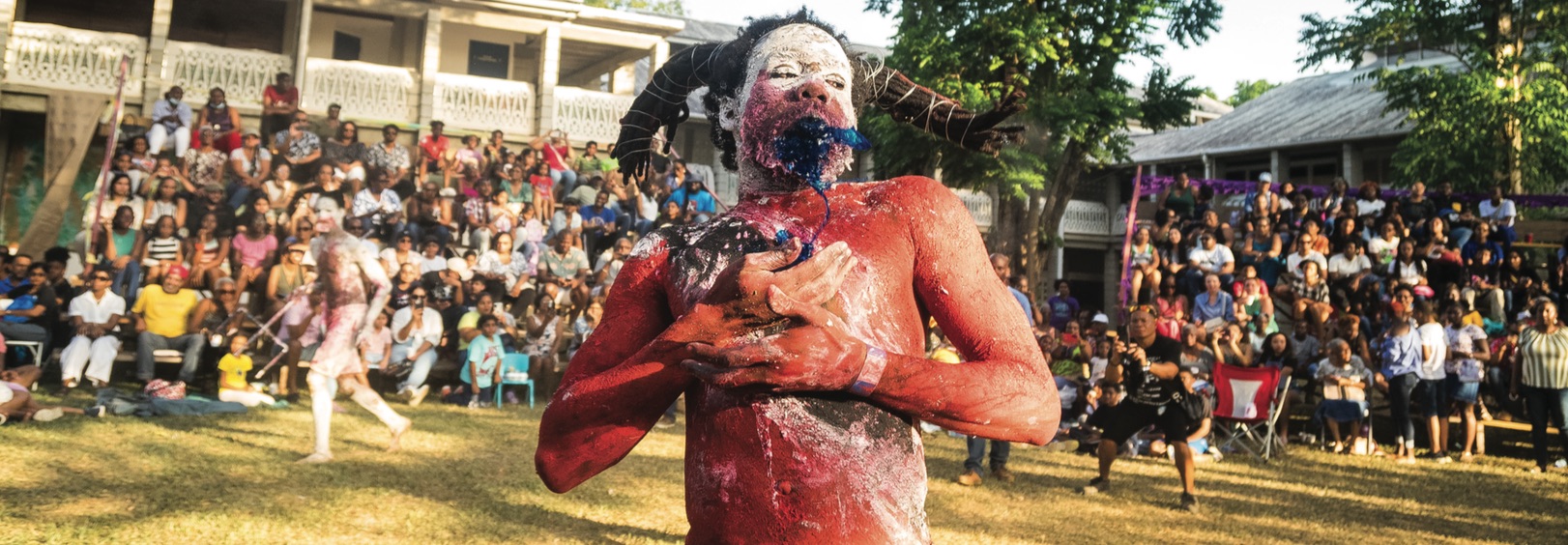
A jab molassie covered in red, white, and black, gives a terrifying and surprisingly patriotic performance during UWI St Augustine’s Old Yard 2024. Carnival is both one of the most recognisable aspects of Trinidad and Tobago culture and the product of several cultures coming together. A process that continues to this day. PHOTO: KC MEDIA LTD
The history of Trinidad Carnival is rooted in its connection to colonialism and migration. In the 18th century, French colonisers transplanted their culture of Carnival to Trinidad, and it has transformed throughout the centuries. Originally, a celebration exclusively for whites, the expression, freedom, and second world that Carnival provided could not be contained. The enslaved Africans who were imported to work in the sugar industry negotiated their own Carnival space, and Canboulay became significant to that populace who could not access the masquerades and balls of the planter class.
Carnival transformed through the influence of the emancipated blacks, particularly during the era of the Jamette Carnival in the 19th century. Some of the black populace of Port-of-Spain, including migrants from the Eastern Caribbean who came as a source of labour, also lived in the urban slums. From there, emerged the badjohns, chauntelles, and stickbands who influenced the trajectory of Carnival that became regarded by those of the upper classes as lewd and obscene.
As Carnival continued to evolve, so too did the rise of various characters like Baby Dolls, Dame Lorraines, and Devils; calypso; tamboo bamboo bands; and steelbands, which were the sounds of the black working class into the 20th century.
The East Indian community, who came to work as indentured labourers on the plantations, also contributed to the diversity of Trinidad Carnival. Chutney music, tassa drums, and Hindi made an impact on calypso/soca music, inspiring the creation of the chutney soca genre. Some songs which celebrated Indian culture, such as Chris Garcia’s Chutney Bacchanal and Drupatee and Machel Montano’s Indian Gyal, became mainstream and were embraced across the region. Indian dress has also influenced costume design for masquerade.
Trinidad has a history of embracing the cultures of its migrants, and its Carnival is no exception. Trinidad’s connections to Venezuela go back to the Pre-Columbian time of the indigenous peoples who often came from South America to settle on the island. Despite Spanish settlement in both the South American mainland and Trinidad in the late 15th century, migration from Venezuela to Trinidad experienced a significant increase after the British seized Trinidad from Spain in 1797.
Due to abolitionist movements in Britain to end the trans-Atlantic slave trade and ultimately African enslavement, peons from Venezuela came to Trinidad in droves to work from the early 19th century and settled in several agricultural areas. They were also referred to as “cocoa panyols” since they worked on cocoa estates. Political and social turmoil in South America also led to the migration of wealthy and prominent Venezuelans, such as Antonio Gomez, a Spanish-born secretary of a Venezuelan Royalist General who was sent as a diplomat to the British Governor of Trinidad in 1813, and who subsequently performed the role of Assessor to Governor Woodford, the fourth and longest serving British Governor of Trinidad. Gómez eventually purchased the large La Pastora Cocoa Estate in the Santa Cruz valley, and settled there.
In the past, some aspects of Venezuelan culture have remained in Trinidad, including pastelles, empanadas, parang, and its accompanying musical instruments, like the cuatro and mandolin. The burrokeet, a traditional Carnival character which gives the illusion of a dancer riding a small donkey, is part of Venezuelan tradition where the rider performs a dance.
From 2015, political and socio-economic unrest in Venezuela led to higher levels of poverty and the subsequent record-breaking migration of millions of Venezuelans to various parts of the world. Currently, Venezuelans comprise the largest group of migrants in Trinidad. Their presence is seen and heard in the current landscape, including Carnival.
In 2020, Maria Nuitter De Espinal showcased at Carnival La Burriquita, the Burrokeet mas to Spanish music. Nuitter is involved in a children’s project that promotes the preservation of La Burriquita and moko jumbies of Trinidad and Tobago, which were showcased by Venezuelan and Trinidadian participants at Kiddies Carnival this year.
In 2022, a Pan to the Poet series was launched to assist with the integration and harmony between Trinbagonians and Venezuelans residing in the country, through the steelpan. During Carnival 2023, Iwer George performed with a Spanish translator at a Spanish wet fete. A Spanish remix of Hard Fete by Road March winner Bunji Garlin was played on the streets of Port-of-Spain on Carnival Tuesday, and The Queen of Bacchanal, Destra Garcia, released a song, Fuego, which features a Latin musical arrangement to lyrics sung in Spanish and Trinidad Creole English.
In so doing, Destra not only showcased her versatility but also enhanced the appeal of soca to the Latin market with this fusion style. There are many offshoots of soca, and it remains to be seen whether Latin soca becomes another category and whether it will appeal to local and Latin performers resident in Trinidad and Tobago.
Trinidad Carnival is all inclusive, not referring only to the experience which typically characterises fetes of this nature, but it is also all inclusive in terms of the cultural expressions it incorporates of its many people which is linked to the island’s history and culture of migration.